DictionaryLiverLiver
LiverThe liver is one of the largest organs in the human body, accounting for 2% to 3% of average body weight and located in the right side of the abdominal cavity, beneath the diaphragm. It consists of two lobes that are supplied with blood by two large blood vessels, the hepatic artery and the portal vein. Each lobe is divided into hexagonal hepatic lobules arranged by plates of hepatocytes radiating out from a terminal branch of the hepatic vein - the central vein. Hepatic lobules are surrounded on average by six portal tracts each. A portal tract comprise an arteriole branch of the hepatic artery, a venule branch of the portal vein and one or several bile ductules. Blood enters through the portal triads, flows through sinusoids located between hepatocytes plates, and drains to the central vein. The hepatocyte is a polygonal cell that usually contains a single, central nucleus and occasional brownish pigment representing intracellular bile. The hepatocytes are usually arranged in one-cell thick plates called muralia with a sinusoid on either side thus exposing the hepatocyte to portal blood at two surfaces. Within the muralium each hepatocyte adjoins the adjacent cell with its outer surface. Bile produced by hepatocytes is collected in grooves in the outer surface of the cell membrane, termed hemicaniculus. The hemicanaliculi of two adjacent hepatocytes together form a thin canal called the intercellular bile canaliculus. The contents of intercellular bile canaliculi flow into a network of larger canals and ducts that eventually merge into bile ducts located in portal tracts. The space of Disse is the space between the hepatocytes and the cells lining the sinusoid wall. Several different cell types including sinusoidal endothelial cells, Kupffer cells and hepatic stellate cells (Ito cells), line the hepatic sinusoids, each with specialized functions.
Cancer: Liver cancer |